This page has 2 sections:
- Day trip possibilities you can choose from
- Photos & detailed descriptions of each place
If you’d like more details about a place, check the 2nd section.
POSSIBILITIES
Overview Tables
🚆 By Train (+Map)
| Name | Outbound | Day Pace | |
|---|---|---|---|
| 3 | Nîmes | 35m | 🟡 Normal |
| 4 | Orange | 15m | 🟢 Relaxed |
| 7 | Isle-sur-la-Sorgue | 25m | 🟢 Relaxed |
| 9 | Arles | 17m | 🟡 Normal |
| 12 | Marseille | 1h10m | 🟡Normal |
| 13 | Montpellier | 1h10m | 🟡Normal |
France Train Map
If you’re taking your day trips by train, our France Train Map for Travelers can help you.
Train Station Locations
Avignon has 2 train stations
1 in the town center
📍 Avignon Centre
and anothher one outside the town, for high-speed trains
📍 Avignon TGV
Orange
📍 Orange
Isle-sur-la-Sorgue
📍 Isle-sur-Sorgue – Fontaine-V
Arles
📍 Arles
Marseille
📍 Marseille Saint-Charles
Montpellier
📍 Montpellier Saint-Roch
📍 Montpellier Sud de France outside the city, for high-speed trains
🚗 By Car
| Name | Outbound | Return | Day Pace | |
|---|---|---|---|---|
| 3 | Nîmes | 50m | Same | 🟡Normal |
| 3b | Nîmes + Pont du Gard | 50m + 35m | 30m | 🟡Normal |
| 3c | Nîmes + Uzès + Pont du Gard | 50m + 35m + 20m | 30m | 🟠Busy |
| 4 | Orange | 35m | Same | 🟢Relaxed |
| 5 | Lubéron Villages | Depends | 1h-1h10m | 🟡Normal |
| 5b | Lubéron Villages + Isle-sur-la-Sorgue | Depends | 45m | 🟠Busy |
| 5c | Lubéron Villages + Fontaine-de-Vaucluse | Depends | 1h10 | 🟠Busy |
| 5e | Lubéron Mountains & Villages 🥾 | 1h-1h10m | Same | 🟡Normal |
| 6 | Lavender Fields | 1h20 | Same | 🟡Normal |
| 6b | Lavender Fields + Lubéron Villages | Depends | Depends | 🟠Busy |
| 7 | Isle-sur-la-Sorgue | 45m | Same | 🟢Relaxed |
| 7b | Isle-sur-la-Sorgue + F. de Vaucluse | 45m + 25m | 1h15 | 🟡Normal |
| 8 | Baux + St. Rémy | 45m + 20m | 30m | 🟢Relaxed |
| 8b | Baux + St. Rémy + Pont du Gard | 45m + 20m + 45m | 30m | 🟠Busy |
| 8c | Alpilles Mountains & Baux 🥾 | 40m | Same | 🟢Relaxed |
| 9 | Arles | 50m | Same | 🟡Normal |
| 9b | Arles + Baux | 50m + 35m | 40m | 🟡Normal |
| 9c | Arles + St. Rémy | 50m + 35m | 30m | 🟡Normal |
| 9d | Arles + Baux + St. Rémy | 50m + 35m + 20m | 30m | 🟠Busy |
| 11 | Aix-en-Provence | 1h10 | Same | 🟡Normal |
| 12 | Marseille | 1h20 | Same | 🟠Busy |
| 13 | Montpellier | 1h20 | Same | 🟠Busy |
| 14 | Dentelles de Montmirail Mountains 🥾 | 1h | Same | 🟡Normal |
| 15 | Mont Ventoux Mountain 🥾 | 1h15 | Same | 🟡Normal |
👨🏻 Guided Tours
| Name | Duration | |
|---|---|---|
| 1 | Multiple Places | 9h to 10h |
| 2 | Wine Tour | 3h to 9h |
| 2b | Wine Tour + Pont du Gard | 5h |
| 2c | Wine Tour + Pont du Gard + Orange | 5h |
| 2d | Wine Tour + Lubéron | 10h |
| 3c | Nîmes + Uzès + Pont du Gard | 5h |
| 3d | Nîmes + Pont du Gard + Orange | 8h |
| 5 | Lubéron Villages | 5.5h |
| 5b | Lubéron Villages + Isle-sur-la-Sorgue | 4.5h to 8h |
| 5c | Lubéron Villages + Fontaine-de-Vaucluse | 5h to 8.5h |
| 5d | E-Bike Lubéron & Villages 🚲 | 8h |
| 6 | Lavender Fields | 5h to 8.5h |
| 6b | Lavender Fields + Lubéron Villages | 5h to 9h |
| 8b | Baux + St. Rémy + Pont du Gard | 5h |
| 9c | Arles + St. Rémy | 6.5h |
| 9d | Arles + Baux + St. Rémy | 5h to 8h |
| 9e | Arles + Baux + St. Rémy + P. du Gard | 8.5h |
| 10 | Camargue Wetlands | 9h |
| 10b | Arles + Camargue Wetlands | 9.5h |
List
👨🏻 1. Multiple Places
Make the most of your day with a combo tour that hits several top spots around Avignon – great if you’re short on time.
- Tours
Duration 9h to 10h
👨🏻 2. Wine Tour
Meet winemakers in the Rhône Valley, visit vineyards, and enjoy guided tastings in the heart of Provence’s wine country.
- Tours
Duration 3h to 9h
👨🏻 2b. Wine Tour + Pont du Gard
A perfect combo of taste and history: wine tastings followed by a stop at the legendary Pont du Gard.
- Tours
Duration 5h
👨🏻 2c. Wine Tour + Pont du Gard + Orange
A wine-focused day with two extra highlights: the Pont du Gard and Roman landmarks in Orange.
- Tours
Duration 5h
👨🏻 2d. Wine Tour + Lubéron
If you love wine and pretty villages, this is your tour. Tastings in the vineyards and strolls through charming Lubéron spots.
- Tours
Duration 10h
🚆🚗 3. Nîmes
A classic Roman city, known for its massive arena and its city center. Easy to reach from Avignon by train or car.
- By Train
Avignon > Nîmes 35min
Nîmes > Avignon Same
Day Pace 🟡Normal
- By Car
Avignon > Nîmes 50min
Nîmes > Avignon Same
Day Pace 🟡Normal
🚗 3b. Nîmes + Pont du Gard
Step into Roman times with a visit to Nîmes, then head to the incredible Pont du Gard, towering over the Gardon River.
- By Car
Avignon > Nîmes 50min
Nîmes > Pont du Gard 35min
Pont du Gard > Avignon 30min
Day Pace 🟡Normal
🚗👨🏻 3c. Nîmes + Uzès + Pont du Gard
A classy trio on this guided tour: Roman Nîmes, medieval Uzès, and the iconic Pont du Gard aqueduct.
- By Car
Avignon > Nîmes 50min
Nîmes > Uzès 35min
Uzès > Pont du Gard 20min
Pont du Gard > Avignon 30min
Day Pace 🟠Busy
- Tours
Duration 5h
👨🏻 3d. Nîmes + Pont du Gard + Orange
A culture-packed route with three major Roman sites: Nîmes arena, the Pont du Gard, and the ancient theater in Orange.
- Tours
Duration 8h
🚆🚗 4. Orange
Orange has one of the best-preserved Roman theaters in the world (still used for shows). There’s also a triumphal arch and other Roman ruins to explore.
- By Train
Avignon > Orange 15min
Orange > Avignon Same
Day Pace 🟢Relaxed
- By Car
Avignon > Orange 35min
Orange > Avignon Same
Day Pace 🟢Relaxed
🚗👨🏻 5. Lubéron Villages
Drive around or join a guided tour to discover some of the most beautiful villages in the Lubéron: like Gordes, Roussillon, and Lourmarin, etc.
- By Car
Avignon > 1 Village 1h to 1h10min
1 Village > 1 Village 10 to 20min
1 Village > Avignon 1h to 1h10min
Day Pace 🟡Normal
- Tours
Duration 5.5h
🚗👨🏻 5b. Lubéron Villages + Isle-sur-la-Sorgue
A peaceful day out among colorful villages and the lovely Isle-sur-la-Sorgue, famous for antiques and canals.
- By Car
Avignon > 1 Village 1h to 1h10min
1 Village > 1 Village 10 to 20min
1 Village > Isle-sur-la-Sorgue 20 to 30min
Isle-sur-la-Sorgue > Avignon 45min
Day Pace 🟠Busy
- Tours
Duration 4.5h to 8h
🚗👨🏻 5b. Lubéron Villages + Fontaine-de-Vaucluse
Pair the Lubéron villages with Fontaine-de-Vaucluse, a deep valley village with a powerful natural spring.
Avignon > 1 Village 1h to 1h10min
1 Village > 1 Village 10 to 20min
1 Village > Fontaine-de-Vaucluse 20 to 30min
Fontaine-de-Vaucluse > Avignon 1h10min
Day Pace 🟠Busy
- Tours
Duration 5h to 8.5h
👨🏻 5d. E-Bike Lubéron & Villages 🚲
Ride an e-bike through postcard landscapes in the Lubéron, stopping off at hilltop villages along the way, smooth and scenic.
- Tours
Duration 8h
🚗 5e. Lubéron Mountains + Villages 🥾
Mix hiking in the Luberon mountain range with strolling through one or more of its villages of your choice. A day of local trails with great views and cultural stops.
- By Car
Avignon > Lubéron 1h to 1h10min
Lubéron > Avignon Same
Day Pace 🟡Normal
🚗👨🏻 6. Lavender Fields
In season, late june to late july, head out to the purple plateaus around Sault or Valensole. It’s all color and scent.
- By Car
Lavender fiels are located near two main areas: Sault and Valensole.
Avignon > Sault Area 1h20min
Sault Area > Avignon Same
Day Pace 🟡Normal
The Valensole area is quite far, about 2h from Avignon, so it’s better to visit this part with a guided tour.
- Tours
Duration 5h to 8.5h
🚗👨🏻 6b. Lavender Fields + Lubéron Villages
A seasonal guided trip that blends blooming lavender fields and charming Lubéron villages: pure Provence.
- By Car
Avignon > Lavender Fields 1h to 1h10min
Lavender Fields > 1 Village 10 to 20min
1 Village > 1 Village 10 to 20min
1 Village > Avignon 1h to 1h10min
Day Pace 🟠Busy
- Tours
Duration 5h to 9h
🚆🚗 7. Isle-sur-la-Sorgue
A cute riverside town nicknamed “little Venice,” famous for antiques, waterwheels, and a chill canal vibe. Super easy to get to.
- By Train
Avignon > Isle-sur-la-Sorgue 25min
Isle-sur-la-Sorgue > Avignon Same
Day Pace 🟢Relaxed
- By Car
Avignon > Isle-sur-la-Sorgue 45min
Isle-sur-la-Sorgue > Avignon Same
Day Pace 🟢Relaxed
🚗 7b. Isle-sur-la-Sorgue + F. de Vaucluse
The perfect duo: wander along the water in Isle-sur-la-Sorgue, then visit Fontaine-de-Vaucluse with its mysterious spring.
- By Car
Avignon > Isle-sur-la-Sorgue 45min
Isle-sur-la-Sorgue > Fontaine-de-Vaucluse 25min
Fontaine-de-Vaucluse > Avignon 1h15min
Day Pace 🟡Normal
🚗 8. Baux + St. Rémy
Go check out two gems in the Alpilles: Les Baux-de-Provence, a dramatic hilltop village with castle ruins, and Saint-Rémy, known for its pretty little streets and its connection to Van Gogh.
- By Car
Avignon > Baux 45min
Baux > St. Rémy 20min
St. Rémy > Avignon 30min
Day Pace 🟢Relaxed
🚗👨🏻 8b. Baux + St. Rémy + Pont du Gard
Join a guided tour that mixes Provençal charm in Saint-Rémy, medieval vibes in Les Baux, and the iconic Pont du Gard – a massive Roman aqueduct listed by UNESCO.
Avignon > Baux 45min
Baux > St. Rémy 20min
St. Rémy > Pont du Gard 45min
Pont du Gard > Avignon 30min
Day Pace 🟠Busy
- Tours
Duration 5h
🚗 8c. Alpilles Mountains & Baux 🥾
Hit the trails through wild landscapes with garrigue, olive trees, and rocky ridges. Hike in the Alpilles and explore the hilltop village of Les Baux, expect stunning views all along the way.
- By Car
Avignon > Alpilles 40min
Alpilles > Avignon Same
Day Pace 🟢Relaxed
🚆🚗 9. Arles
Whether you drive or take the train, Arles is an easy day out. Roman arenas, colorful streets, and a Van Gogh vibe everywhere you look.
- By Train
Avignon > Arles 17min
Arles > Avignon Same
Day Pace 🟡Normal
- By Car
Avignon > Arles 50min
Arles > Avignon Same
Day Pace 🟡Normal
🚗 9b. Arles + Baux
This trip combines the Roman history of Arles with the medieval charm of Les Baux. You’ll also get to enjoy the beautiful countryside between the two.
- By Car
Avignon > Arles 50min
Arles > Baux 35min
Baux > Avignon 40min
Day Pace 🟡Normal
🚗👨🏻 9c. Arles + St. Rémy
Start with Roman history in Arles, then head to Saint-Rémy for its Provençal charm and ancient ruins. You can drive it yourself or go with a guide – either way, it’s a great combo.
- By Car
Avignon > Arles 50min
Arles > St. Rémy 35min
St. Rémy > Avignon 30min
Day Pace 🟡Normal
- Tours
Duration 6.5h
🚗👨🏻 9d. Arles + Baux + St. Rémy
A full day of Roman sites, hilltop villages, and Provençal lifestyle – with a small group and expert guide.
- By Car
Avignon > Arles 50min
Arles > Baux 35min
Baux > St. Rémy 20min
St. Rémy > Avignon 30min
Day Pace 🟠Busy
- Tours
Duration 5h to 8h
👨🏻 9e. Arles + Baux + St. Rémy + P. du Gard
The best of south Provence and Roman heritage in one guided day trip: Arles, Les Baux, Saint-Rémy, and the famous Pont du Gard.
- Tours
Duration 8.5h
👨🏻 10. Camargue Wetlands
Get into the wild side of Provence: spot pink flamingos, white horses, and bulls in their natural habitat. The Camargue’s got a salty, untamed vibe you’ll love.
- Tours
Duration 9h
👨🏻 10b. Arles + Camargue Wetlands
Culture and nature, all in one go: guided visit in Arles, then off to the Camargue marshes to see the local wildlife and learn about bull traditions.
- Tours
Duration 9.5h
🚗 11. Aix-en-Provence
Elegant and artsy, Aix charms with its fountains, markets, and classy architecture.
- By Car
Avignon > Aix-en-Provence 1h10min
Aix-en-Provence > Avignon Same
Day Pace 🟡Normal
🚆🚗 12. Marseille
Hop on a train or drive down to Marseille – check out the Old Port, the Panier district, the cathedral, and the basilica.
- By Train
Avignon > Marseille 45min (With 1 Connection) or 1h10min (Direct)
Marseille > Avignon Same
Day Pace 🟡Normal
- By Car
Avignon > Marseille 1h20min
Marseille > Avignon Same
Day Pace 🟠Busy
🚆🚗 13. Montpellier
Lively and full of contrast – medieval streets meet bold modern buildings. A fun day out for strolling, museum-hopping, and people-watching.
- By Train (Direct or With 1 Connection)
Avignon > Montpellier 1h10min
Montpellier > Avignon Same
Day Pace 🟡Normal
- By Car
Avignon > Montpellier 1h20min
Montpellier > Avignon Same
Day Pace 🟠Busy
🚗 14. Dentelles de Montmirail Mountains 🥾
Gorgeous hiking trails through jagged ridges with sweeping views of the Gigondas vineyards and nearby mountains.
- By Car
Avignon > Dentelles de Montmirail 1h
Dentelles de Montmirail > Avignon Same
Day Pace 🟡Normal
🚗 15. Mont Ventoux Mountain 🥾
Hike or drive up the “Giant of Provence” for breathtaking views. A must for hikers.
- By Car
Avignon > Mont Ventoux 1h15min
Mont Ventoux > Avignon Same
Day Pace 🟡Normal
🥾 = Hiking
Blank = not possible or too complicated (train or bus), too long or little interest without a guide (car), or doesn’t exist (guided tours).
Day Pace takes into account travel time, how easy it is to get around once you’re there (including parking difficulty if you’re driving), and how much there is to see.
It can vary quite a bit depending on how much you choose to visit – just the highlights or a more in-depth experience – so the idea here is an average.
For guided tours, it’s not the pace that’s shown but the duration.
Map
PHOTOS & DESCRIPTIONS
The places are listed in alphabetical order.
Aix-en-Provence City

Elegant and full of light, Aix-en-Provence is the perfect example of that relaxed Provençal lifestyle. Founded by the Romans and once the historic capital of Provence, the city draws you in with its shady squares, trickling fountains, grand 17th- and 18th-century mansions, and a vibe that’s both peaceful and full of life. At the heart of it all is the Cours Mirabeau: a wide, tree-lined avenue with classy facades, lively cafés, and sunny terraces where time seems to slow down.
Aix is also Cézanne’s hometown, he was born here in 1839. You can visit his studio, Atelier des Lauves, which has been left just as he used it, giving you a real sense of how he worked. The Montagne Sainte-Victoire, located east of the city which he painted over and over, was one of his biggest sources of inspiration.
Aix also has a strong cultural side. the Hôtel de Caumont, a beautifully restored mansion, hosts refined temporary exhibitions in a stunning setting. And the Musée Granet has a solid collection of works from the 17th century all the way to modern art. On the edge of town, the Vasarely Foundation dives into optical art in a striking modern space.
Alpilles Mountain Range
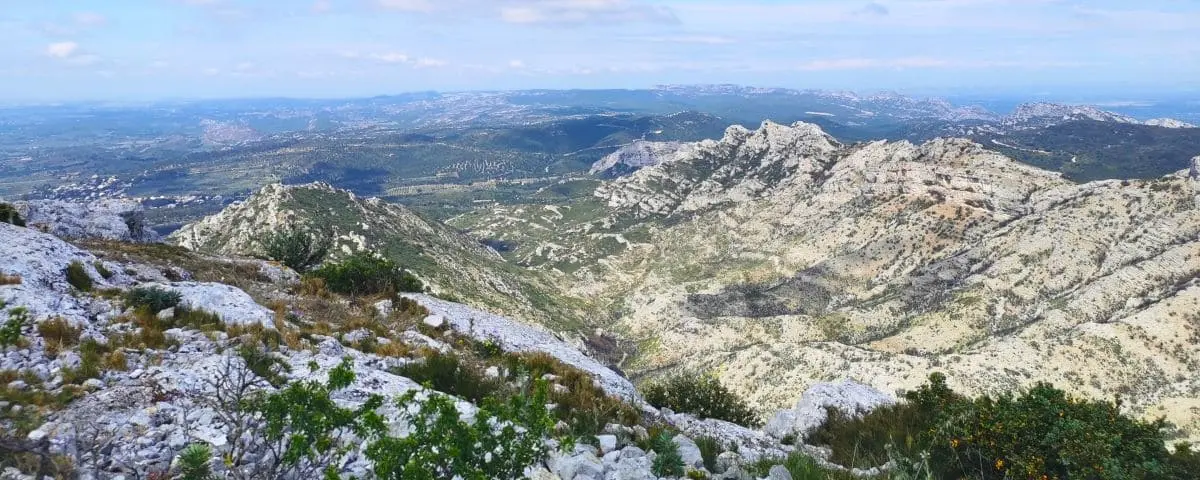
The Alpilles may be a small limestone range in the heart of Provence, but they unfold into a series of stunning landscapes, white ridgelines, fragrant garrigue, and endless olive groves. The bare rock is everywhere, shaped by wind and time into a dramatic, rugged terrain. Even though the mountains aren’t very tall, the views they offer are absolutely breathtaking.
Driving through the Alpilles on those winding back roads is pure joy if you’re after peace and authenticity. Along the way, you’ll pass dry stone walls, forgotten sheepfolds, little Romanesque chapels, and old farmhouses shaded by towering cypress trees. The light here is something special, it brings out the golden tones of the stone and the silvery shimmer of the olive trees.
This landscape, so loved by painters like Van Gogh, is also perfect for hiking. There are plenty of marked trails that take you along ridges, through hidden valleys, and across wild ravines where cicadas sing in the summer heat. Far from the tourist crowds, the Alpilles offer a slower kind of discovery, all about raw nature, quiet heritage, and that laid-back Provençal lifestyle.
Arles Town
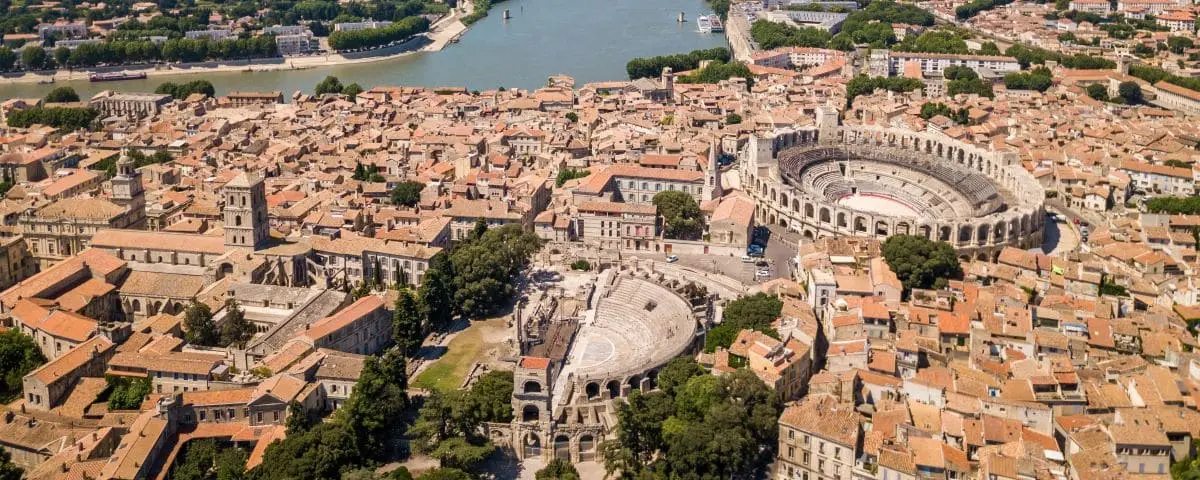
Arles is a city full of art and history, part ancient, part medieval, and very much alive today. It used to be a Roman colony, and you can still see some incredible archaeological sites. Right in the heart of the old town, you’ve got the Roman amphitheater, which is beautifully preserved and still hosts shows today. Just a short walk away, there’s the ancient theater, and you’ll find a few other Roman ruins scattered around town too.
But Arles isn’t just about its Roman past, the medieval side of the city runs deep too. Just look at the beautiful Saint-Trophime cloister and its sculpted doorway, an example of Provençal Romanesque art. It reflects how important Arles was back in the Middle Ages, when it was the seat of a powerful archbishopric.
As you wander through the old town, you’ll see just how lively and charming this place really is. It’s a maze of narrow, often cobbled streets, lined with colorful facades and pastel shutters. You’ll spot elegant, low-key townhouses from the 17th and 18th centuries right next to humble little churches and shaded squares where locals chat in their sing-song Provençal accent over coffee.
Arles has managed to keep a really authentic vibe, everyday life and heritage blend together naturally here. Markets, art galleries, small shops, and old-school craft stores all keep the local spirit very much alive.
Van Gogh also left his mark here. He painted some of his most famous works in Arles. Even though none of his paintings are actually kept in the city, you can follow a route through the places that inspired him, it’s a cool way to see the town through his eyes.
And Arles has a strong creative streak today too. Every summer, the city turns into a huge open-air gallery during the Rencontres de la Photographie, a world-famous photography festival. And if you’re into contemporary art and architecture, don’t miss the Luma Foundation, it’s set in a former industrial site and shows off a whole new side of Arles.
Baux-de-Provence Village
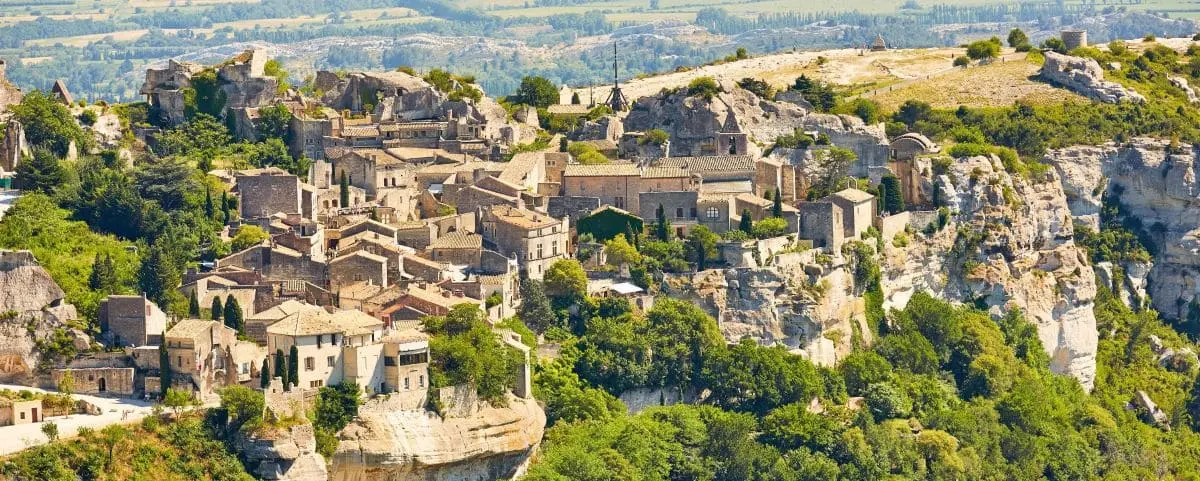
Perched on a rocky outcrop in the heart of the Alpilles, the village of Les Baux-de-Provence will blow you away, both for its stunning natural setting and its rich heritage. If you come in through the backroads, you’ll drive through vineyards and jagged rocks before suddenly arriving at this stone eagle’s nest, where the houses look like they’re part of the cliff itself. The way the village is laid out is pretty wild, it honestly feels like it’s been dropped right onto the rock.
At the top, you’ve got the Château des Baux. It’s mostly in ruins, but it’s full of history, and the view from up there is just incredible. You can see the whole region spread out below you.
Just a short walk from the village center, the Carrières des Lumières offer a totally different kind of experience, but one you won’t forget. These old limestone quarries have been turned into a massive immersive art show, with famous artworks projected onto the walls and set to music. It’s a sound-and-light spectacle that’s magical for all ages, and they switch up the theme every season with new artists.
Les Baux-de-Provence is a perfect stop on a trip through the Alpilles, between charming villages, dramatic landscapes shaped by wind and sun, and cultural gems at every turn. It’s pretty much the dream image of Provence: sun-soaked, rugged, and full of emotion.
Camargue Wetlands
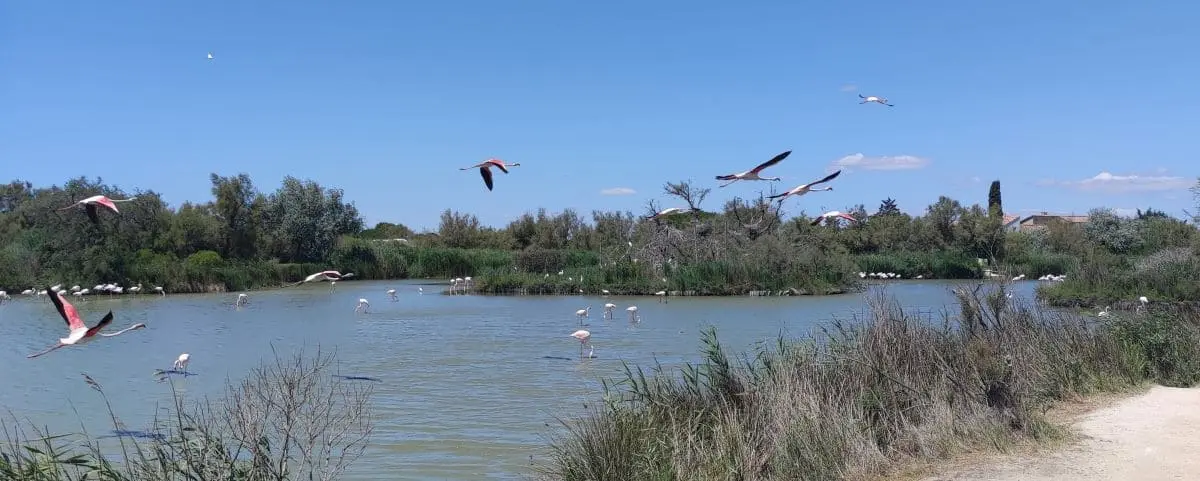
The Camargue is a wild, one-of-a-kind part of Provence, a vast delta where the Rhône meets the Mediterranean. It’s a land of contrasts, with marshes, lagoons, rice fields, and salt flats, all ruled by nature. The whole region has a strong identity, blending incredible landscapes, age-old traditions, and amazing wildlife.
You’re in a regional natural park here, with rich but fragile ecosystems. One of the highlights? Spotting thousands of birds, especially the iconic pink flamingos, roaming free across the wetlands. Wildlife is everywhere, white horses living semi-free, black bulls from local ranches, migrating birds… You’ll feel how deeply connected this place is to nature.
But the Camargue is also shaped by people and tradition. Bull and horse breeding are a big deal here, with local herders, called manadiers, and bull games that keep a vibrant culture alive. There’s also a strong Gypsy influence, especially in the town of Saintes-Maries-de-la-Mer, which is known for its lively pilgrimages, music, and spiritual energy.
As you follow the winding roads through salt flats, dikes, and marshes, you’ll come across raw, windswept landscapes that feel totally untouched. Authentic, off-the-beaten-track, and full of life, the Camargue offers a completely different kind of Provence, where sky, water, and land all blend into something unforgettable.
Dentelles de Montmirail Mountain Range
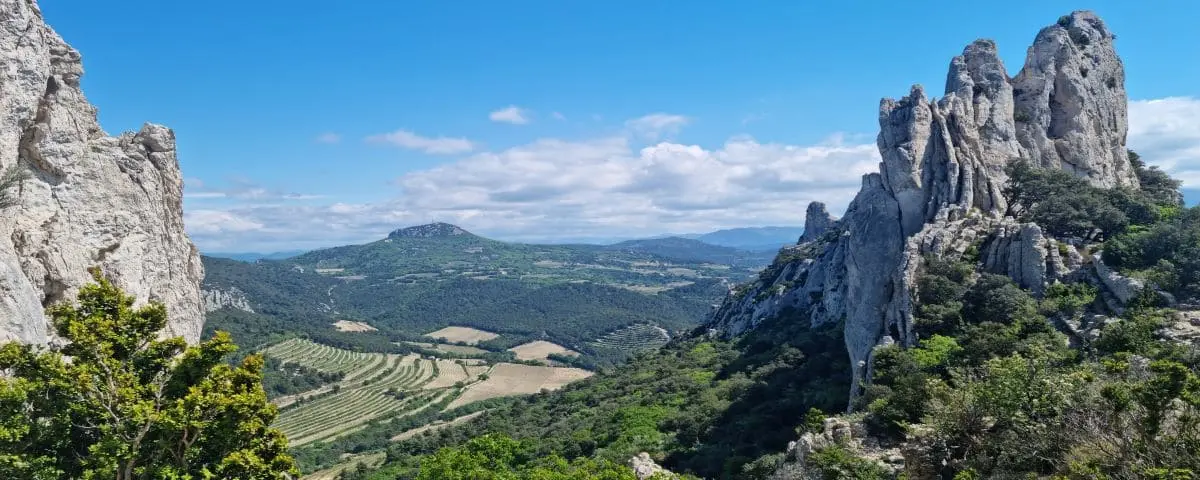
This small limestone range, with its sharp peaks that look like stone lace, rises between several villages. It’s a dream spot for hikers and climbers, and for anyone who loves authentic Provençal scenery.
The trails wind through pine forests, rocky scree slopes, and vineyard terraces, all with a backdrop of jagged peaks and steep cliffs. Along the way, you’ll get incredible views over the Rhône plain, nearby villages, and on a clear day, even all the way to Mont Ventoux.
The vibe here is both wild and raw, far from the crowds of the big tourist spots.
Fontaine-de-Vaucluse Town
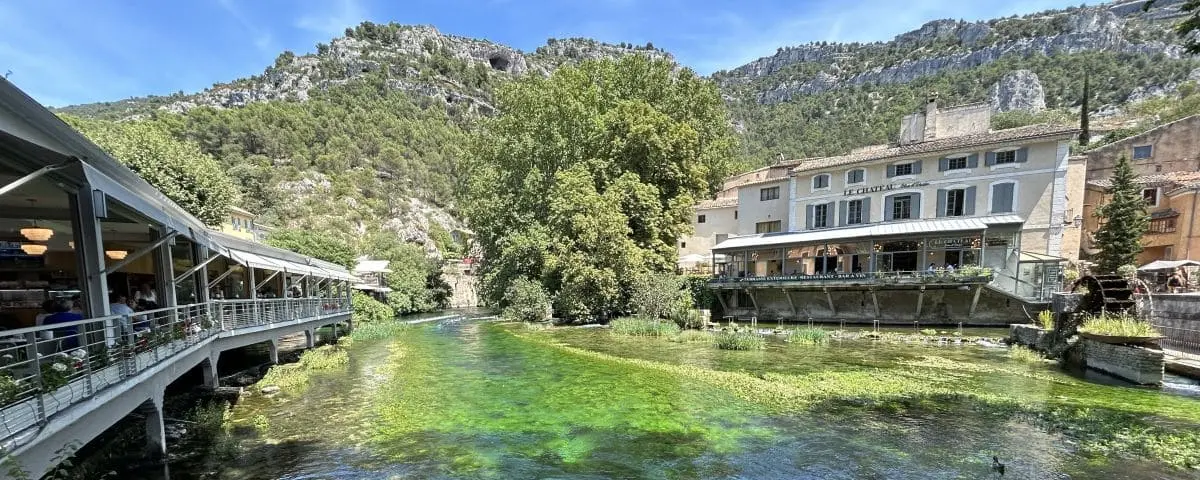
Tucked at the base of a tall limestone cliff, Fontaine-de-Vaucluse will grab your attention right away with its dramatic setting and its powerful spring, one of the biggest in France. The Sorgue River starts here, bursting out of a deep, mysterious cave in a raw, striking landscape that’s both rocky and lush.
The village stretches out along the river, with a cool, shaded atmosphere that’s super relaxing. At the far end, there’s a path that leads you to the famous spring, this deep pool with emerald green water that’s seriously impressive. In spring, when the snow melts and the water table rises, it turns into a crazy natural show, gushing out thousands of liters every second.
Isle-sur-la-Sorgue Town
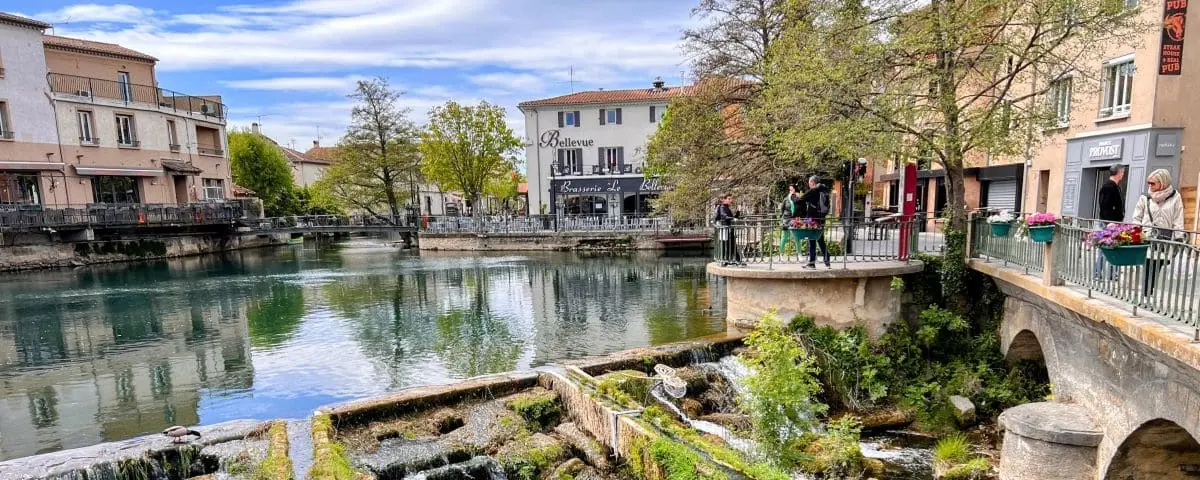
Nicknamed the “Venice of Provence,” L’Isle-sur-la-Sorgue will charm you right away with its canals, moss-covered waterwheels, and peaceful yet elegant vibe. The town is built around branches of the Sorgue river, crystal-clear water coming from the famous Fontaine-de-Vaucluse spring, and it really does feel like an island surrounded by water.
As you stroll through the old town, you’ll spot colorful facades, old mansions, shady little squares, and plenty of art galleries. But what really makes L’Isle-sur-la-Sorgue stand out is its antiques scene. With hundreds of shops and warehouses grouped into special “villages,” it’s one of the top spots in Provence for vintage finds and decorative arts.
Thursdays, and especially Sundays, are extra special, when the food market takes over the town. It’s full of life, with local producers, artisans, and bargain hunters all mingling along the scenic riverside. It’s the perfect time to taste regional products and browse the colorful stalls.
Lavender Fields
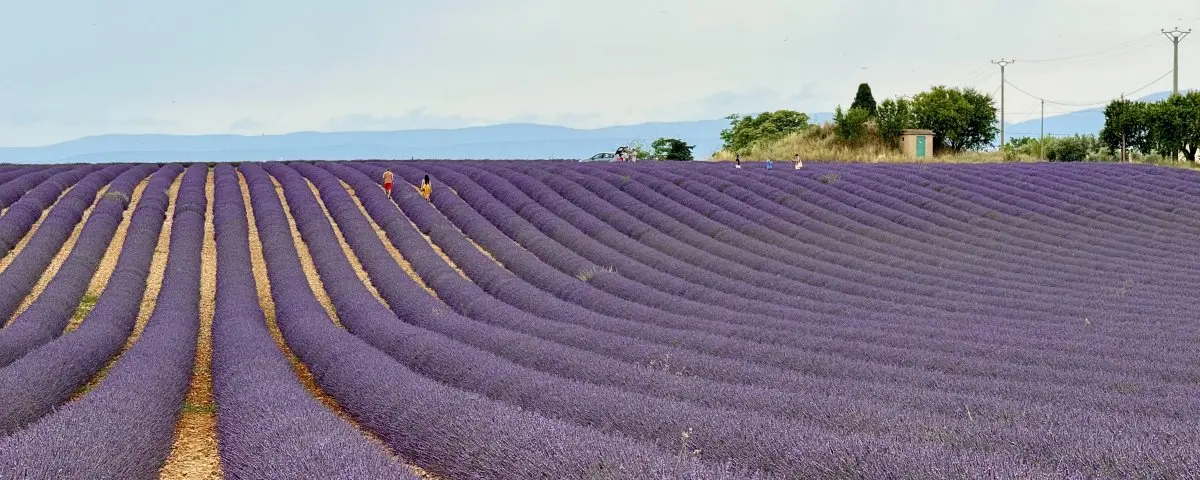
Lavender fields are one of the most iconic sights in Provence, and when they’re in bloom, they turn the landscape into a full-on sensory experience. Between late June and late July (depending on the location and altitude), the fields light up in shades of blue and purple, drawing visitors and photographers from all over the world.
The Valensole Plateau is one of the most famous spots. As far as you can see, perfectly aligned rows of lavender stretch across the land, often bordered by golden wheat or bright sunflowers. The mix of colors, plus that strong, sweet smell, makes it totally unforgettable.
Another amazing place to see lavender is the Sault Plateau. The scenery here is just as stunning, with lavender-filled valleys and mountain peaks in the background.
You’ll also find a few lesser-known lavender patches in the Luberon, which tend to be quieter but just as lovely. That said, one spot really stands out, and it’s actually quite famous: the garden of Sénanque Abbey, near the village of Gordes. It’s home to a lavender field that’s become one of the iconic sights in the region.
Lavender isn’t just pretty, it’s also grown for its medicinal and aromatic properties. As you drive through the countryside, you’ll come across small, local distilleries offering products like essential oils, soaps, and natural cosmetics.
If you catch the lavender in bloom, you’re in for a real treat, it’s a deep dive into the soul of Provence, with dazzling light, intoxicating scents, and rural traditions that are still very much alive.
Lubéron Mountain Range
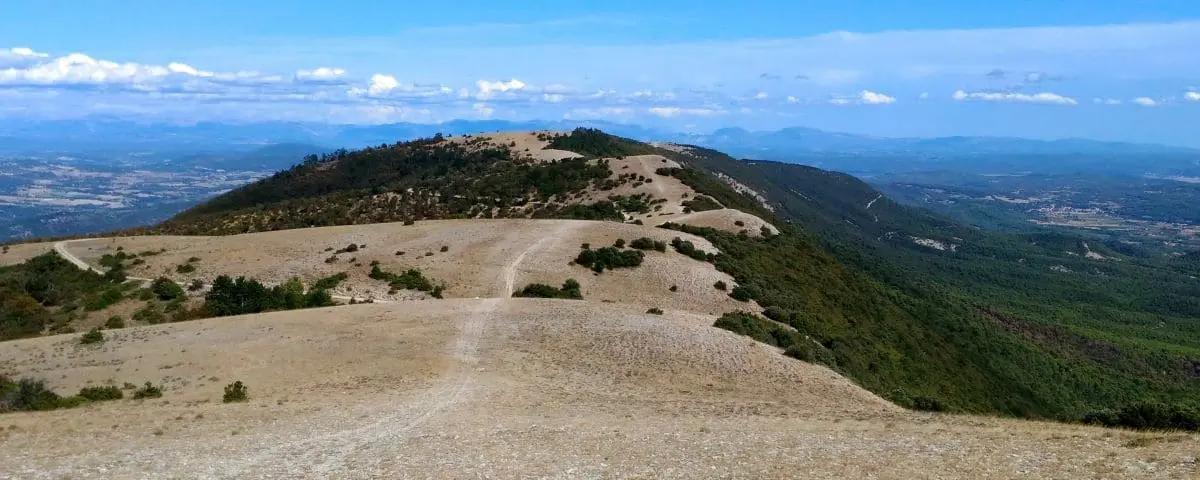
The Luberon isn’t just about pretty hilltop villages, it’s also a fantastic place to hike. The whole area is part of a regional natural park, which helps protect its landscapes and local heritage. The range itself is split into the Petit and Grand Luberon, and it’s crisscrossed with marked trails for all levels.
If you’re up for more of a challenge, you can head up the slopes of the Grand Luberon all the way to the top of Mourre Nègre, the highest point in the range at 1,125 meters. From up there, the view is incredible: you’ll see the Mont Ventoux, the Alps, and the Rhône Valley all at once.
Whether you’re in the mood for a gentle stroll through vineyards and olive groves or a tougher climb through the forest, the Luberon delivers. Every trail gives you a taste of real Provence: unspoiled nature, old rural charm, and jaw-dropping views.
Lubéron Villages
Photo 1/6 Gordes

Photo 2/6 Roussilon
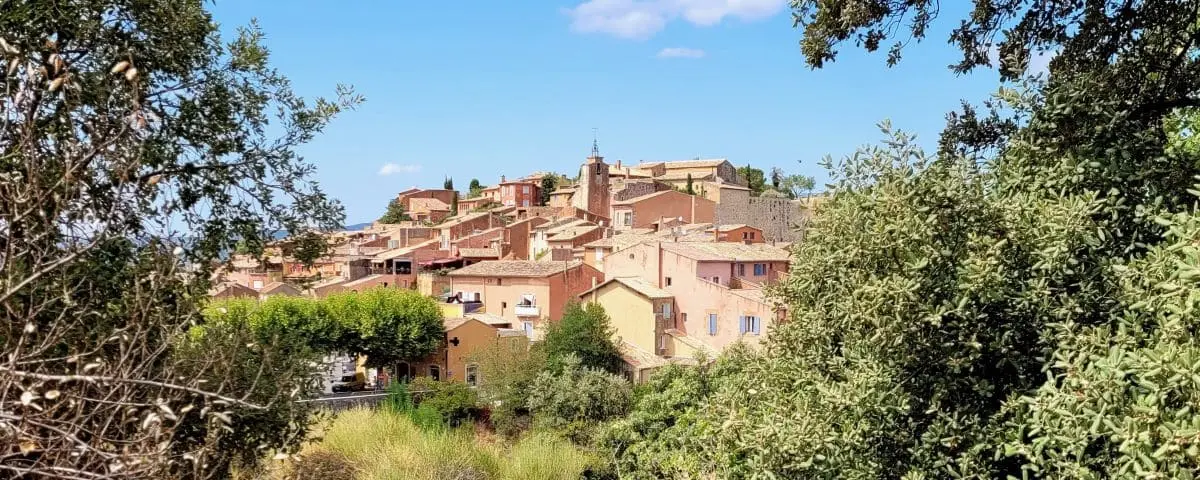
Photo 3/6 Ménerbes
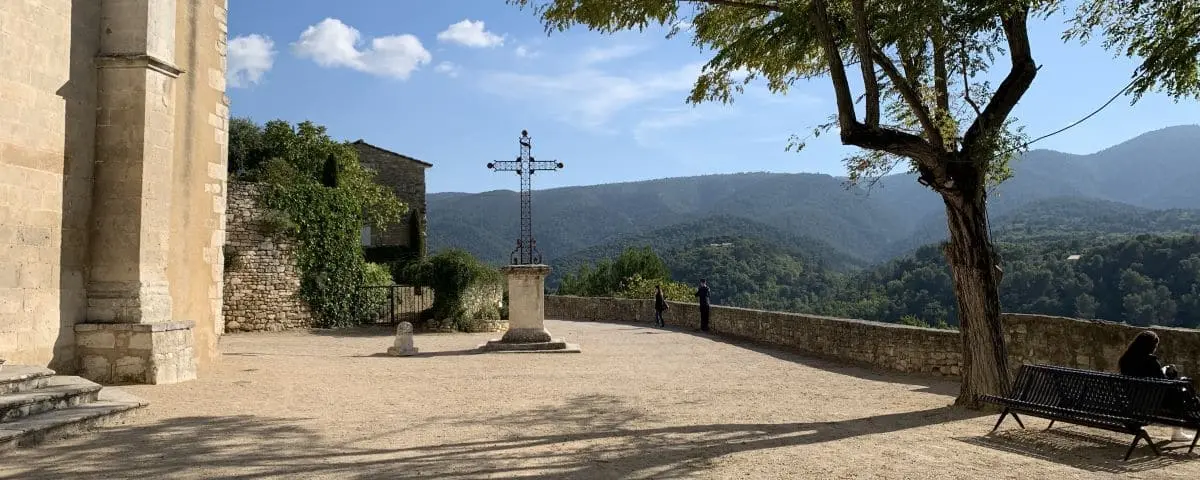
Photo 4/6 Lacoste
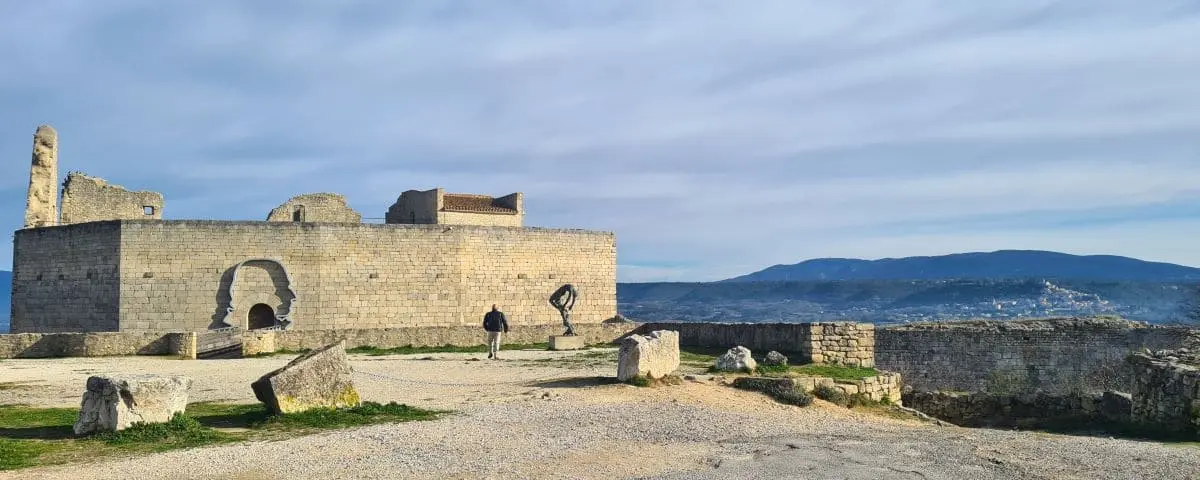
Photo 5/6 Bonnieux
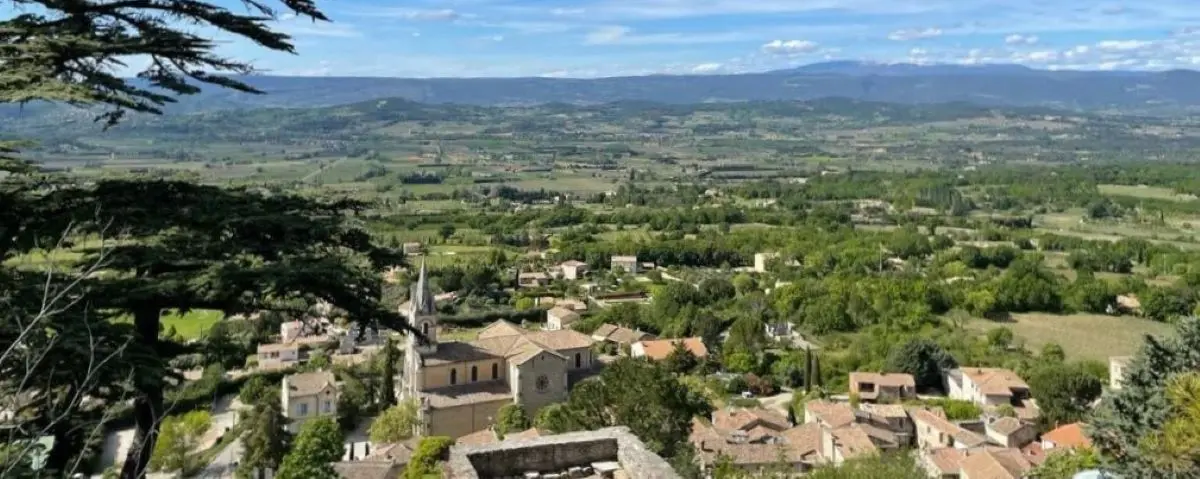
Photo 6/6 Oppède-le-Vieux

The Luberon is the perfect countryside escape, full of sunshine, charm, and postcard-worthy hilltop villages. Scattered across limestone hills, each little stone village has its own vibe, mixing history, views, and that laid-back Provençal lifestyle.
Gordes is probably the most iconic. Perched high above the Calavon plain, it’s all about elegance, dry-stone houses stacked around a Renaissance château, cobbled lanes, hidden art galleries, and a killer view.
Just outside the village, the Sénanque Abbey gives you one of the iconic views of Provence, with its grey stone walls and a field of lavender stretching out below. It was founded in the 12th century and is still home to a community of monks today.
Just a few miles away, Roussillon will catch you off guard with its explosion of color. The village sits on a former ochre deposit, and everything, from the cliffs to the house walls, glows in warm shades of red, orange, and yellow. Don’t miss the Ochre Trail, a short hike through a landscape of colored rock formations.
Ménerbes is quieter and a bit off the beaten path. Once home to artists and writers, it charms with narrow lanes, elegant old stone houses, and peaceful views over surrounding vineyards and orchards.
Lacoste, just across the valley, has a strong medieval feel. It’s overlooked by the ruins of the Marquis de Sade’s château, and filled with cobblestone alleys, arched passageways, and a few artists’ studios.
Facing Lacoste, Bonnieux stretches along the slope of a hill, topped by an old church with amazing views over the Petit Luberon. The village flows down in layers: terraces, stairways and shaded squares.
And then there’s Oppède-le-Vieux, the wildest of them all. Less restored than the others, it has a haunting beauty: medieval ruins, a church perched high above, and half-abandoned houses that give it a timeless, mysterious feel. It’s perfect if you’re after something a little more off-grid.
Exploring these villages is like stepping into a living painting: golden light, dramatic cliffs, rows of vines, and a deep sense of peace.
Marseille City

Lively, full of contrast, and totally one-of-a-kind, Marseille can be a bit confusing at first, but that’s also what makes it so fascinating. It’s the oldest city in France, founded by the Greeks 2,600 years ago, and it’s packed with energy and personality. The city beats to the rhythm of the Vieux-Port, which has been totally revamped. Every morning, you can catch the fish market there, right by the water.
Just around the corner, the Panier neighborhood feels like a little village of its own. Think steep alleyways, colorful facades, buzzing little squares, and a great mix of cultures, all with cool street art, surprising architecture, and plenty of friendly spots to eat.
Two major landmarks tower over the city and the sea: the Cathédrale de la Major and Notre-Dame-de-la-Garde. The Major, sitting between the Old Port and the Joliette district, is massive and striking, with its green-and-white striped domes and neo-Byzantine style. And high up on a hill, Notre-Dame-de-la-Garde has been watching over the city. Climb up there and you’ll get one of the best views of Marseille, the sea, and the Frioul Islands.
Marseille also takes culture seriously. You can’t miss the Mucem, a bold piece of modern architecture set between the sea and the city. Its lace-like concrete walls and hanging walkways connect it to the old Fort Saint-Jean, and the views over the harbor are just stunning.
Set between the sea and the hills, Marseille doesn’t leave anyone indifferent. It’s a bold mix of deep-rooted traditions and cutting-edge creativity, of gritty street life and surprising beauty, and once you get into its rhythm, it’s hard not to fall for it.
Montpellier City
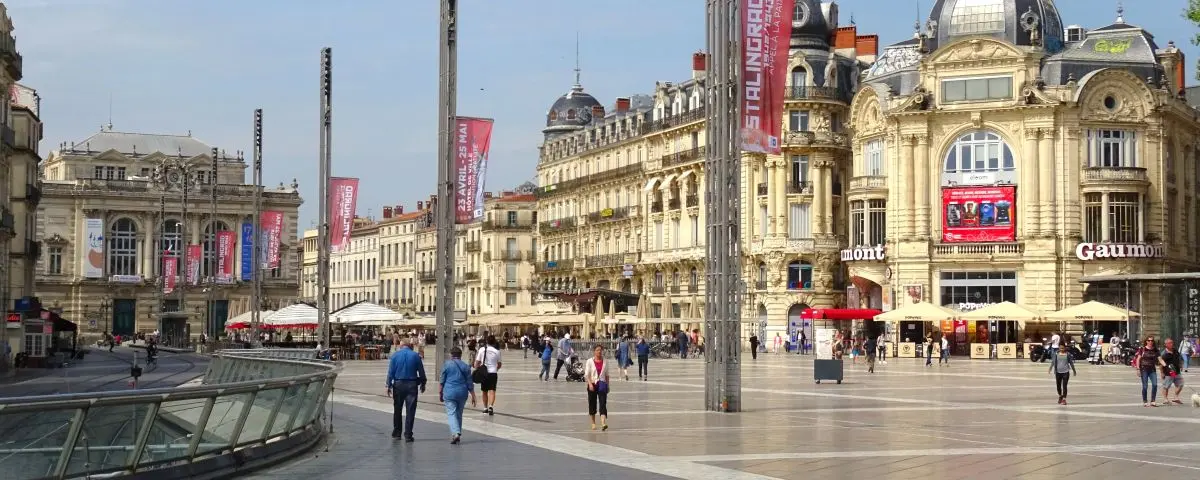
Montpellier has long been a city of trade and learning. it’s home to one of the oldest medical schools in Europe, and it’s still up and running today.
The historic center is a maze of medieval alleyways, elegant townhouses with fancy balconies, lively little squares, and hidden courtyards waiting to be found. At the heart of it all is Place de la Comédie, a huge, always-buzzing square that links the old city to the newer, modern parts. It’s the kind of place where everything happens: street performers, cafés, people coming and going at all hours.
The city mixes it all together: museums, street art, bright-colored trams, leafy gardens, and a big student scene. The result? A southern vibe that’s sunny, energetic, and seriously creative.
Mont Ventoux Mountain
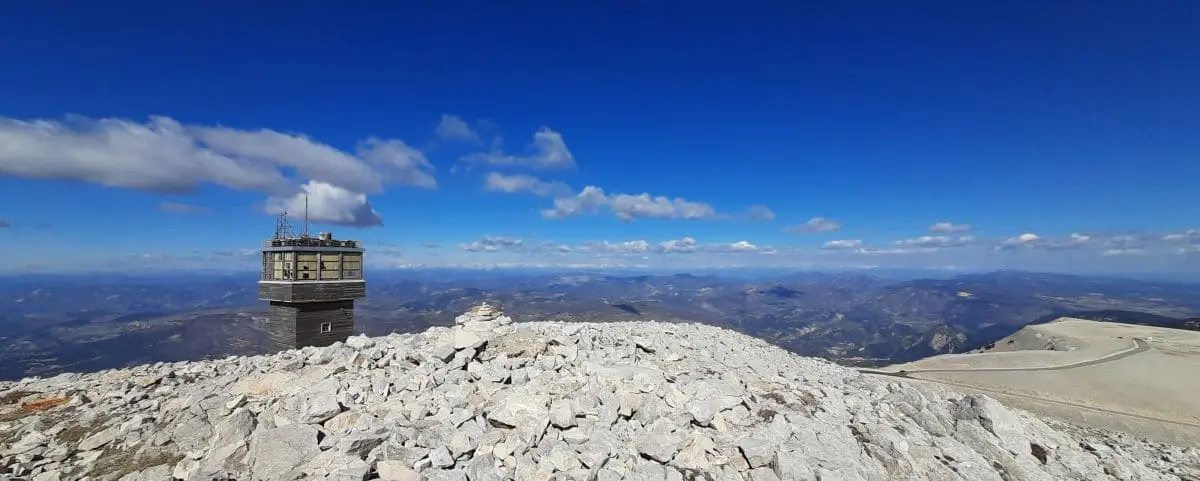
At 1,910 meters, Mont Ventoux is the highest peak in the region, and it towers over Provence with real presence. They call it the “Giant of Provence,” and it definitely lives up to the name. Hikers, cyclists, and curious visitors all come to experience its otherworldly landscapes and incredible views.
You can hike up to the top from different routes. The most hardcore hikers start from lower down, but most people choose higher-altitude starting points that offer easier and more varied walks, through beech forests, alpine meadows, and rocky ridgelines.
As you make your way up, the landscape keeps changing, from Mediterranean woods to windswept grasslands and piles of loose stone, until you reach the bare summit. From up there, the views are just wild: you can see the Alps, the Cévennes, the Rhône Valley, and even the Mediterranean on a clear day.
You can also reach the top by car: scenic roads (open in season) let you drive up or start a hike halfway. It’s a great option if you want the views without the full-on climb.
Whether you’re here for a serious hike or just a peaceful stroll, a challenge or a moment to take it all in, Mont Ventoux lets you experience it your own way.
Nîmes City
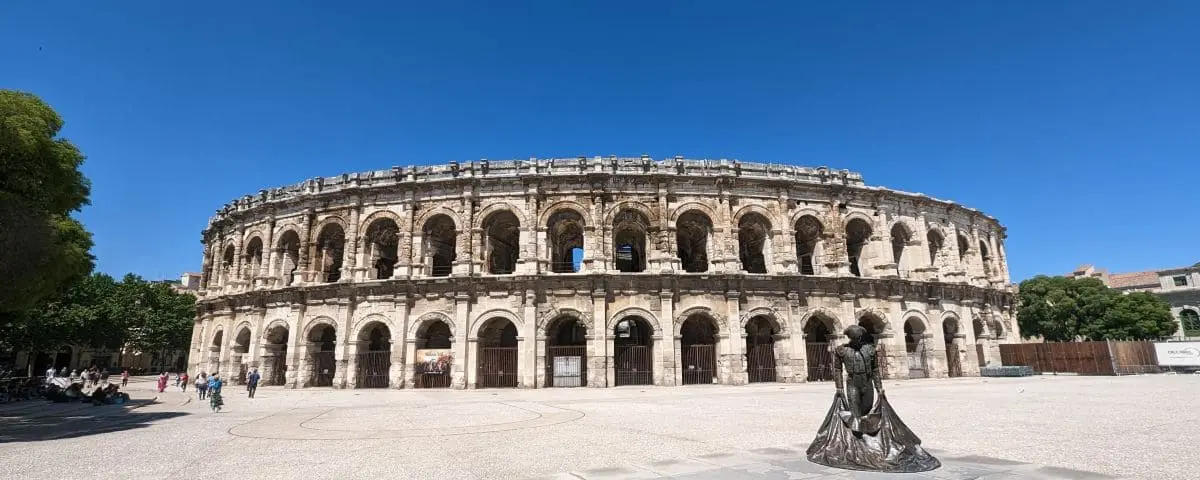
Nîmes, sometimes called the “French Rome,” is a must if you’re into ancient architecture. The city has some of the best-preserved Roman monuments anywhere, and as you walk around, it really feels like you’re stepping back in time. The star of the show is the Arènes de Nîmes, a 1st-century amphitheater that’s incredibly well preserved. They still use it today for concerts and bullfights. The acoustics are amazing, and honestly, it’s one of the best-kept Roman arenas in the world.
Right nearby, you’ll find another spot: the Maison Carrée, a perfectly proportioned Corinthian temple that’s stood the test of time. And just across from it, the sleek Carré d’Art, a cultural center and media library, shows how the city blends its ancient roots with modern flair.
But there’s more to Nîmes than just Roman ruins. The old town is pedestrian-friendly and full of life, with winding streets, old houses, cool little shops, shaded squares, and lively café terraces.
Pont du Gard Bridge
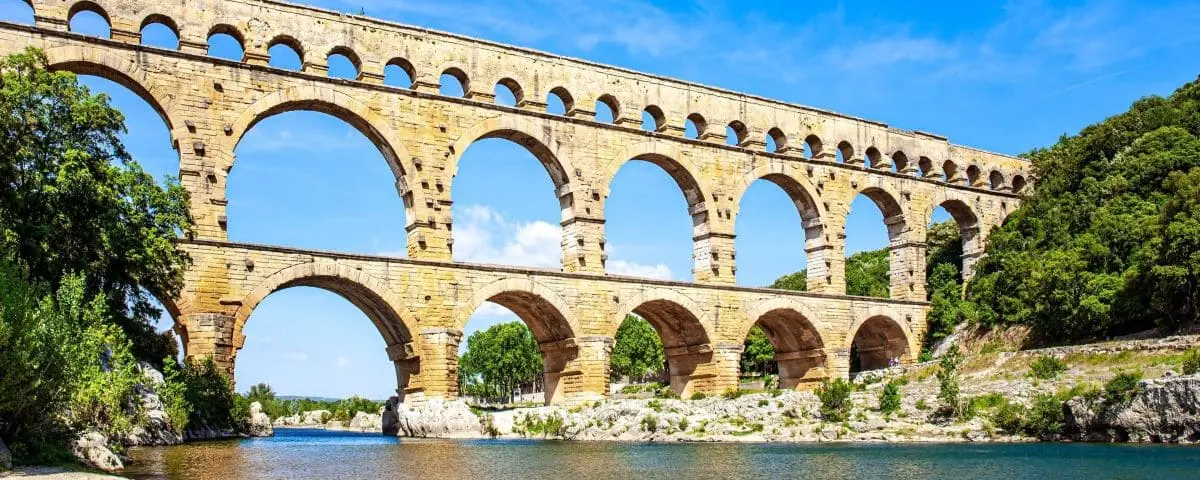
The Pont du Gard is a masterpiece of Roman engineering, and it’s just as impressive for its beauty as it is for the technical feat behind it. Built in the 1st century AD to carry water to the city of Nîmes, this massive three-level aqueduct stretches gracefully across the Gardon River. At nearly 50 meters high, it’s the tallest known Roman aqueduct bridge and one of the best-preserved ancient monuments in the world.
But it’s not just about the architecture, the whole site is really well set up for visitors. There’s a modern museum where you can dive into the history, engineering, and human effort that went into building it. The exhibits do a great job of explaining how the aqueduct worked, how the Romans built it, and how water was used back in the day.
After the visit, you can go for a walk along the Gardon River, the trails give you some amazing views of the bridge, especially at sunset. And if it’s warm out, you can swim or go canoeing right below the aqueduct in the clear river water. It’s a UNESCO World Heritage site, but it also feels super relaxed and close to nature.
Orange Town
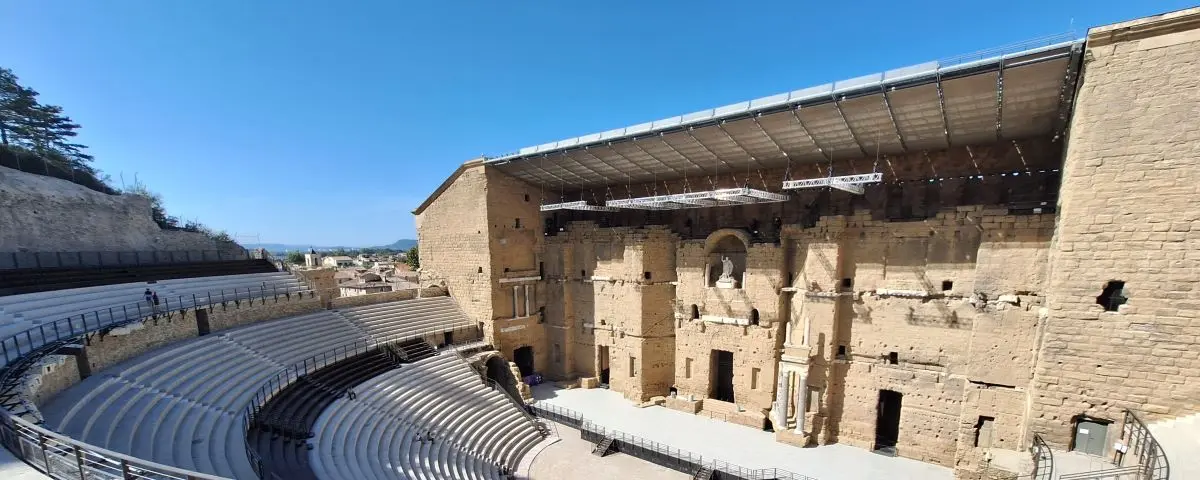
Orange is a must if you’re into ancient history. This former Roman colony is famous for two monuments, both listed as UNESCO World Heritage Sites. The most iconic one is the Roman Theatre, one of the best-preserved in the entire Roman world. Its massive stage wall, over 30 meters high, is seriously impressive and full of atmosphere. They still use it today for concerts, and the acoustics are truely amazing.
The other spot is the Triumphal Arch, at the northern entrance to town. It was built under Emperor Augustus to celebrate the victories of the Roman legions and stands out for its finely carved reliefs. It also marks the start of the ancient Via Agrippa, a key Roman road that once connected Lyon to Arles.
But Orange isn’t just about ancient stones. The old town is really pleasant to wander through, you’ll find little shopping streets, lively squares, and some elegant old townhouses. The vibe is peaceful and relaxed, blending Roman heritage with that Provençal charm.
St. Rémy-de-Provence Town
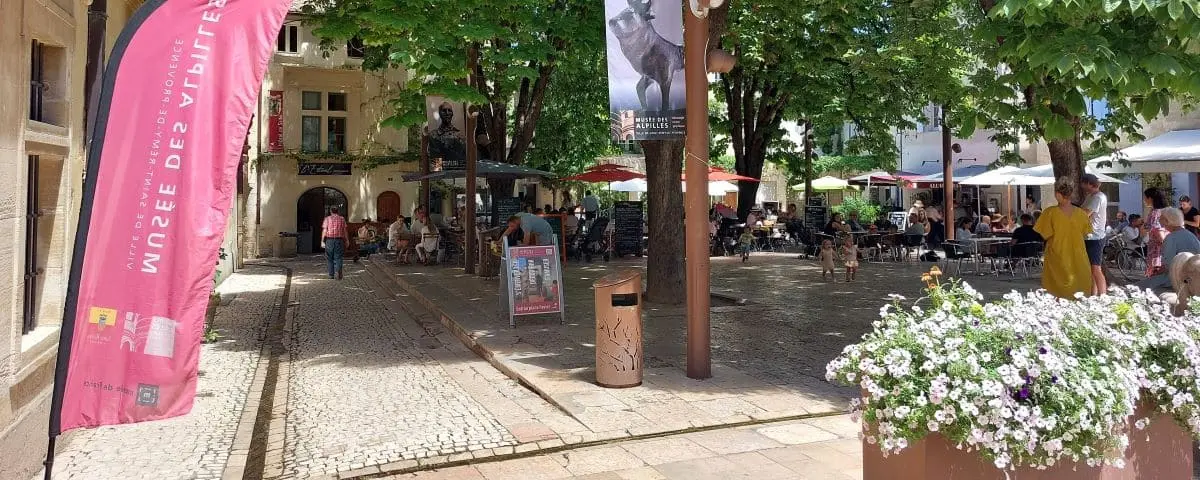
Saint-Rémy-de-Provence is a must when you’re exploring the Alpilles. It’s one of those places that perfectly blends charm, history, and that laid-back Provençal vibe. This little town is super popular, and it’s easy to see why, narrow streets lined with plane trees, beautiful old stone mansions, and a mix of elegance and authenticity that just works.
Wandering around the old town is a real pleasure. You’ve got lively café terraces, little fountains, and stylish boutiques that are fun to browse. If you’re there on a Wednesday morning, don’t miss the big market, it completely takes over the center and gives you a real taste of Provence: full of colors, scents, and amazing local products.
Another side of Saint-Rémy you shouldn’t miss is its connection to Vincent van Gogh. He stayed here from May 1889 to May 1890 at the Saint-Paul-de-Mausole asylum, and it’s where he painted some of his most famous works, inspired by the bright landscapes around the Alpilles. Today, there’s a walking trail that takes you through the spots that sparked his creativity.
Saint-Rémy isn’t just is packed with Roman history too. Just south of the village, you’ll find the archaeological site of Glanum, where you can walk among the remains of a Gallo-Roman city, forums, baths, homes, temples, all surprisingly well preserved. Right next door, in the middle of nature, are two impressive Roman monuments known as “Les Antiques”, a mausoleum and a triumphal arch that are seriously worth a look.
With its museums, art galleries, and peaceful atmosphere, Saint-Rémy-de-Provence really captures the spirit of Provence, where tradition meets artistic inspiration.
Uzès Town
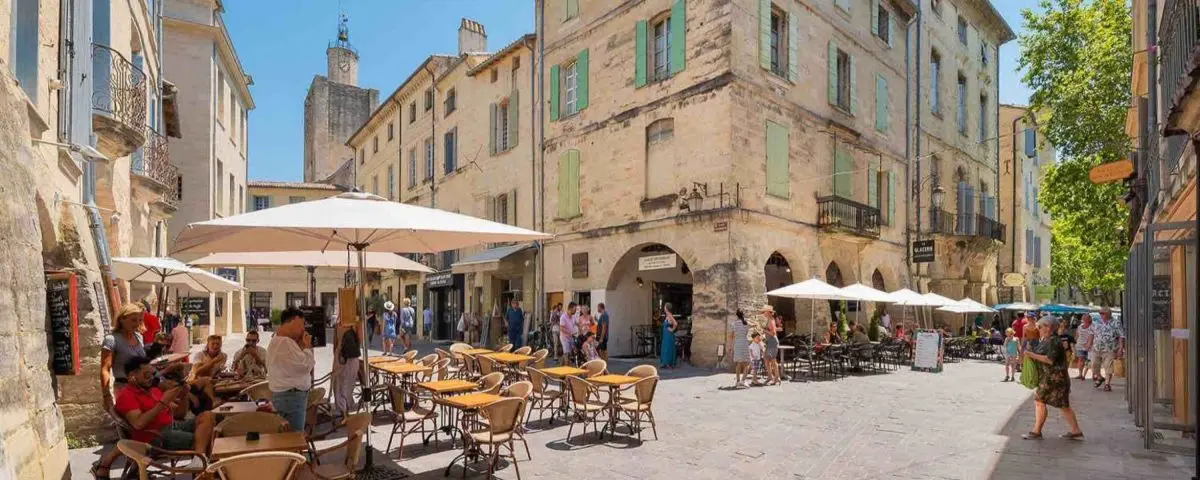
Uzès is one of those places that wins you over the moment you arrive. It’s elegant, peaceful, and full of charm, with beautifully preserved medieval and classical architecture everywhere you look. As you wander the cobbled streets, you’ll come across shady little squares, grand old townhouses, and vaulted arcades, it’s like stepping into a postcard.
At the heart of town is Place aux Herbes, a big square lined with arches that comes alive every Wednesday and Saturday morning with one of the prettiest markets in the South of France. It’s packed with local produce, Provençal scents, and that warm, friendly vibe you only get at a proper southern market.
But there’s more to Uzès than just the good life. The Duchy, still home to the same family after all these centuries, sits proudly above the town with its tower, chapel, and colorful tiled roofs. You can actually visit the inside and get a glimpse of noble life, with fancy salons, historic rooms, and amazing views over the rooftops.
If you’re into culture, Uzès has some cool museums too, like the pottery museum or the Georges Borias Museum, which is set inside a former bishop’s palace. And throughout the year, the town hosts festivals and exhibitions that bring even more life to its quiet charm.
Vineyards
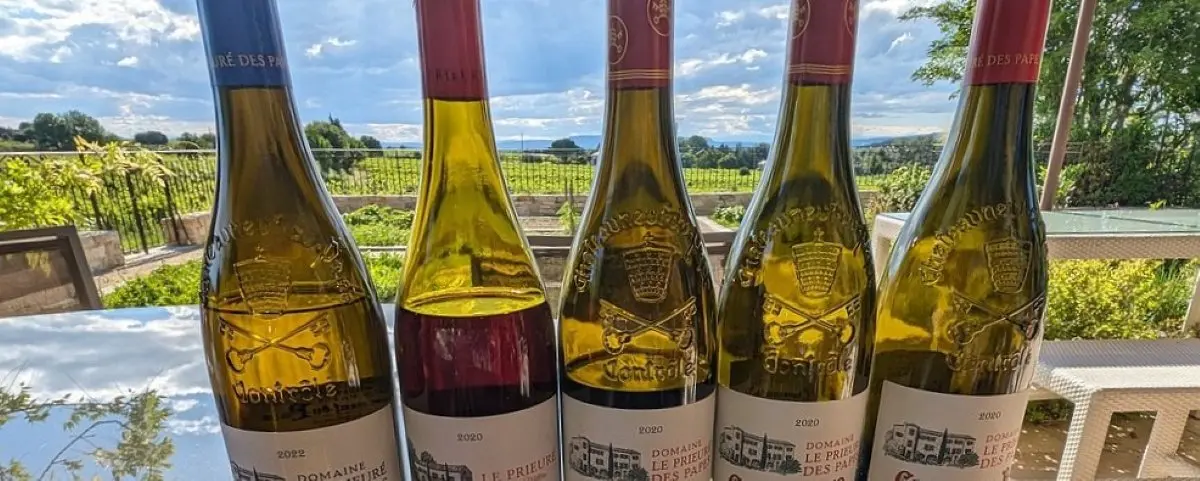
Between Avignon and Orange, the vineyards of Châteauneuf-du-Pape stretch across a prestigious terroir shaped by history and sun. This is one of the Rhône Valley’s most famous wines, and it all starts with a rocky soil covered in smooth round stones that soak up the heat during the day and release it back to the vines at night. The hot, dry climate combined with a mix of grape varieties creates bold, structured wines that are full of flavor.
You’ll find tons of wine cellars in the area where you can taste different styles of the appellation. Around forty estates offer tastings, often with passionate explanations about vine growing, blending, and what makes the local terroir so special. Most of the wine is red, but you can also come across some rare whites.
Driving through the vineyards, exploring cool vaulted cellars, or sitting down for a guided tasting at a small family-run estate, these are all great ways to really get a feel for what makes this place so unique. Whether you’re a wine lover or just curious to experience a more authentic, delicious side of Provence, Châteauneuf-du-Pape is definitely worth a stop.
